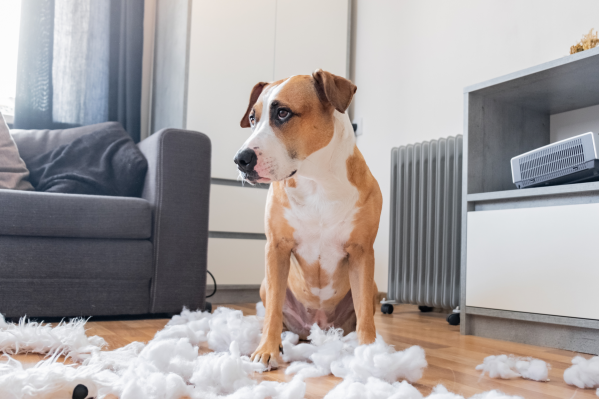There are few things as exciting as getting a new puppy.
While you’re no doubt more than ready to welcome your new pup with open arms, your house might not be completely up to snuff in providing a safe environment for your new furry family member.
Before you bring your puppy home, it’s important to make sure you’ve puppy proofed your house.
Unsure of what you need to do to make sure everything is safe and sound? The team at Pawp is here 24/7 to give you guidance on how to make sure your home is ready to have a puppy roaming around.
To get you started, here are some suggestions to make your home puppy-ready.
14 ways to puppy proof your house
1. Get the essentials for your pup
Your new puppy will need some essential items like food, a leash, and dog toys already set up before they come to your home.
Some of these items, such as a crate or dog gate, also directly help you puppy proof your house. A dog gate, for example, will keep your little furry friend out of areas that may be hazardous to them.
2. Keep your trash secured and away
Puppies are very curious, and there are few things that will be more interesting to them than a bag full of smelly garbage.
Make sure that all your garbage bins—even smaller ones in the bathroom—have lids on them so a puppy can’t get their snout in there and ingest something harmful.
3. Keep your toilet lids down
Speaking of bathrooms, don’t underestimate your puppy’s ability to jump up and drink out of the toilet bowl, or even potentially fall in. Keep your toilet lids down to avoid this.
4. Move and hide electrical cords
Puppies love to chew things, especially when they’re teething.
If you have electrical cords lying around, you’ll want to hide them in something like a cord holder or put them somewhere where the puppy can’t reach them.
It’s also good to get some appropriate chew toys (one of the essential items listed above) so your pup has things they can safely gnaw on.
5. Say goodbye to poisonous house plants
There are several house plants that are sadly poisonous to dogs.
If you’ve got a green thumb, it’s time to go through your plants to make sure none of them could seriously hurt your pup if they ingest them. Some poisonous house plants are poinsettias, sago palm, sweet pea, and tulips. The list is long, however, so be sure to look up each one to make sure your plants are dog-safe.
If you have a backyard, you should also check the plants out there to make sure they're not poisonous to your pup.
6. Remove or hide choking hazards and small objects
It’s important to not leave any choking hazards lying around.
This means not putting your keys or jewelry on the coffee table, for example, or leaving batteries somewhere where your pup can get them. If you're even questioning whether or not your pup could find and chew it, hide it.
7. Store cleaning supplies away
Like small objects, cleaning supplies are another thing your puppy will be interested in chewing and eating that can make them incredibly sick.
Make sure all your cleaning products are stored well out of reach of your new furry friend.
8. Keep all medications tightly secured
If you keep medications in your house, make sure they are completely out of your pup’s reach.
If you don’t have a medicine cabinet, try putting them in a clasped box on a tall shelf or in a locked closet.
9. Ensure sharp objects are secured and inaccessible
Knives and other sharp objects are something that will obviously hurt your pup if they get their paws on them.
Make sure you keep all these items safely stored away where your puppy can’t reach them and where they can't easily fall on the ground.
10. Install childproof locks on lower cabinets
If you need to create a secure space, you can you use childproof locks on lower cabinets to deny your puppy access.
This also will prevent them from digging through whatever you keep in there, even if it isn’t something extremely harmful to them.
11. Hide backpacks and purses
Puppies are great investigators, and they’d love nothing more than to get their snout into your purse or backpack if those items are left lying around.
You probably don’t want them in there in the first place, but your pup can also potentially get sick if they get ahold of things like gum or lotions, which can be poisonous to them.
12. Lock and close exterior doors and windows
Dogs, especially young ones, will want to explore every nook and cranny of your house. If they come across an open door or window, they won’t hesitate to run outside and potentially get lost or hurt.
Make sure to add locks to all your doors, even a secondary screen door if you want to just use that on warm summer days.
13. Mow and trim your lawn to prevent fleas
If you have a backyard, make sure to keep the grass trim and any debris away so fleas are less likely to reside there and find a new home on your pup.�
Read: Best Flea & Tick Medications of 2022
14. Fence your yard and around pool areas
Your backyard should also be fully fenced off if you want to have your puppy play out there without a leash. If you have a pool, it should also be fully fenced off, so your puppy doesn’t learn the hard way how to swim.
At the end of the day, there's a lot you need to do to prepare a welcoming home for your new puppy. But if you do it right, you're sure to have a happy, healthy life with your new addition.
Sources:
